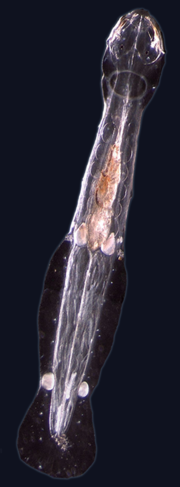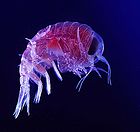- Chaetognatha
-
Arrow worms
Temporal range: Lower Cambrian–Recent
Spadella cephaloptera Scientific classification 
Kingdom: Animalia clade: Bilateria Phylum: Chaetognatha
Leuckart, 1854Classes - Archisagittoidea
- Sagittoidea
Chaetognatha, meaning hair-jaws, and commonly known as arrow worms, are a phylum of predatory marine worms that are a major component of plankton worldwide. About 20% of the known species are benthic, that is belonging to the lowest zone of the ocean, or benthic zone, and can attach to algae and rocks. They are found in all marine waters, from surface tropical waters and shallow tide pools to the deep sea and polar regions. Most chaetognaths are transparent and are torpedo shaped, but some deep-sea species are orange. They range in size from 2 to 120 millimetres (0.079 to 4.7 in).
There are more than 120 modern species assigned to over 20 genera. Despite the limited diversity of species, the number of individuals is large.[1]
Contents
Anatomy
Chaetognaths are transparent or translucent dart-shaped animals covered by a cuticle. The body is divided into a distinct head, trunk, and tail. There are between four and fourteen hooked, grasping spines on each side of their head, flanking a hollow vestibule containing the mouth. The spines are used in hunting, and covered with a flexible hood arising from the neck region when the animal is swimming. All chaetognaths are carnivorous, preying on other planktonic animals.[2]
The trunk bears one or two pairs of lateral fins incorporating structures superficially similar to the fin rays of fish. Unlike those of vertebrates, however, these are composed of a thickened basement membrane extending from the epidermis, and they are not homologous. An additional caudal fin covers the post-anal tail.[2] Two chaetognath species, Caecosagitta macrocephala and Eukrohnia fowleri, have bioluminescent organs in their fins.[3],[4]
Chaetognaths swim in short bursts using a dorso-ventral undulating body motion, where their tail fin assists with propulsion and the body fins for stabilization and steering.[5] Some species are known to use the neurotoxin tetrodotoxin to subdue prey.[6]
The body cavity lacks a peritoneum, and therefore resembles the pseudocoel of animals such as nematodes, but is divided into one compartment on each side of the trunk, and additional compartments inside the head and tail.[2] Although they have a mouth with one or two rows of tiny teeth, compound eyes, and a nervous system, they have no respiratory or circulatory systems.
The mouth opens into a muscular pharynx which contains glands to lubricate the passage of food. From here, a straight intestine runs the length of the trunk to an anus just in front of the tail. The intestine is the primary site of digestion and includes a pair of diverticula near the anterior end.[2]
The nervous system is reasonably simple, consisting of a ganglionated nerve ring surrounding the pharynx. The dorsal ganglion is the largest, but nerves extend from all the ganglia along the length of the body. Chaetognaths have two compound eyes, each consisting of a number of pigment-cup ocelli fused together. In addition, there is a number of sensory bristles arranged in rows along the side of the body, where they probably perform a function similar to that of the lateral line in fish. An additional, curved, band of sensory bristles lies over the head and neck.[2]
Materials are moved about the body cavity by cilia. Waste materials are simply excreted through the skin and anus.
The arrow worm rhabdomeres are derived from microtubules, which in turn form conical bodies, which contain granules and thread structures. The cone body is derived from a cilium, and the microtubules of the rhabdomeres are 20 nm long and 50 nm wide. [7]
Reproduction
All species are hermaphroditic, carrying both eggs and sperm.[1] Each animal possesses a pair of testes within the tail, and a pair of ovaries in the posterior region of the main body cavity. Immature sperm are released from the testes to mature inside the cavity of the tail, and then swim through a short duct to a seminal vesicle where they are packaged into a spermatophore.[2]
During mating, each individual places a spermatophore onto the neck of its partner after rupture of the seminal vesicle. The sperm rapidly escape from the spermatophore and swim along the midline of the animal until they reach a pair of small pores just in front of the tail. These pores connect to the oviducts, into which the developed eggs have already passed from the ovaries, and it is here that fertilisation takes place.[2]
The eggs are planktonic, or attached to nearby algae, and hatch into miniature versions of the adult, without a well-defined larval stage.[2]
Classification
Chaetognaths are traditionally classed as deuterostomes by embryologists. Lynn Margulis and K. V. Schwartz place chaetognaths in the deuterostomes in their Five Kingdom classification.[8] Molecular phylogenists, however, consider them to be protostomes. Thomas Cavalier-Smith places them in the protostomes in his Six Kingdom classification.[9] The similarities between chaetognaths and nematodes mentioned above may support the protostome thesis - in fact, chaetognaths are sometimes regarded as a basal ecdysozoan or lophotrochozoan.[10] Chaetognatha appears close to the base of the protostome tree in most studies of their molecular phylogeny.[11] This may explain their deuterostome embryonic characters. If chaetognaths branched off from the protostomes before they evolved their distinctive protostome embryonic characters, they may have retained deuterostome characters inherited from early bilaterian ancestors. Thus chaetognaths may be a useful model for the ancestral bilaterian.[12] Studies of arrow worms' nervous systems suggests they should be placed within the protostomes.[13][14]
Fossil record
Due to their soft bodies, chaetognaths fossilize poorly. Even so, several fossil chaetognath species have been described.[15] Chaetognaths appear to have originated in the Cambrian Period. Complete body fossils have been formally described from the Lower Cambrian Maotianshan shales of Yunnan, China (Eognathacantha ercainella Chen & Huang[16] and Protosagitta spinosa Hu[17]) and the Middle Cambrian Burgess Shale of British Columbia (Oesia disjuncta Walcott[18]). A more recent chaetognath, Paucijaculum samamithion Schram, has been described from the Mazon Creek biota from the Pennsylvanian of Illinois. Chaetognaths were thought possibly to be related to some of the animals grouped with the conodonts. The conodonts themselves, however, are thought to be related to the vertebrates. It is now thought that protoconodont elements (e.g., Protohertzina anabarica Missarzhevsky, 1973), are probably grasping spines of chaetognaths rather than teeth of conodonts. Previously chaetognaths in the Early Cambrian were only suspected from these protoconodont elements, but the more recent discoveries of body fossils have confirmed their presence then. [19]
References
- ^ a b Bone, Q. et al. (1991). The biology of chaetognaths. London: Oxford University Press. ISBN 019857715X.
- ^ a b c d e f g h Barnes, Robert D. (1982). Invertebrate Zoology. Philadelphia, PA: Holt-Saunders International. pp. 1046–1050. ISBN 0-03-056747-5.
- ^ Haddock, S.H.D. & J.F. Case (2004). "A bioluminescent chaetognath". Nature 367 (6460): 225–226. doi:10.1038/367225a0.
- ^ Thuesen, E.V., F.E. Goetz & S.H.D. Haddock (2010). "Bioluminescent organs of two deep-sea arrow worms, Eukrohnia fowleri and Caecosagitta macrocephala, with further observations on bioluminescence in chaetognaths". Biological Bulletin 219 (2): 100–111. doi:http://pubget.com/paper/20972255. PMID 20972255.
- ^ Jordan, C.E. (1992). "A model of rapid-start swimming at intermediate reynolds number: Undulatory locomotion in the chaetognath Sagitta elegans". Journal of Experimental Biology 163: 119–137.
- ^ Thuesen, E.V. (1991). "The tetrodotoxin venom of chaetognaths". In Bone, Q. et al.. The biology of chaetognaths. London: Oxford University Press. pp. 55–60
- ^ "Photoreception." Encyclopædia Britannica from Encyclopædia Britannica 2006 Ultimate Reference Suite DVD . 2009.
- ^ Systema Naturae 2000 Taxon: Phylum Chaetognatha per Margulis and Schwartz (select Margulis & Schwartz in 'Classification by') - last retrieved November 25, 2006
- ^ Systema Naturae 2000 Taxon: Phylum Chaetognatha per Cavalier-Smith (select Cavalier-Smith in 'Classification by') - last retrieved November 25, 2006
- ^ Matus, D.Q. et al. (2006). "Broad taxon and gene sampling indicate that chaetognaths are protostomes". Current Biology 16 (15): R575–R576. doi:10.1016/j.cub.2006.07.017. PMID 16890509.
- ^ Marletaz, F. et al. (2006). "Chaetognath phylogenomics: a protostome with deuterostome-like development". Current Biology 16 (15): R577–R578. doi:10.1016/j.cub.2006.07.016. PMID 16890510.
- ^ Papillon, Daniel et al. (2004). "Identification of chaetognaths as protostomes is supported by the analysis of their mitochondrial genome". Molecular Biology & Evolution 21 (11): 2122–2129. doi:10.1093/molbev/msh229. PMID 15306659.
- ^ Rieger, V.; Perez, Y.; Müller, C. H. G.; Lipke, E.; Sombke, A.; Hansson, B. S.; Harzsch, S. (2010). "Immunohistochemical analysis and 3D reconstruction of the cephalic nervous system in Chaetognatha: Insights into the evolution of an early bilaterian brain?". Invertebrate Biology 129: 77–104. doi:10.1111/j.1744-7410.2010.00189.x.
- ^ Harzsch, S.; Müller, C. H. (2007). "A new look at the ventral nerve centre of Sagitta: Implications for the phylogenetic position of Chaetognatha (arrow worms) and the evolution of the bilaterian nervous system". Frontiers in Zoology 4: 14. doi:10.1186/1742-9994-4-14. PMC 1885248. PMID 17511857. http://www.pubmedcentral.nih.gov/articlerender.fcgi?tool=pmcentrez&artid=1885248.
- ^ Vannier, J.; Steiner, M.; Renvoise, E.; Hu, S.-X.; Casanova, J.-P. (2007). "Early Cambrian origin of modern food webs: evidence from predator arrow worms". Proceedings of the Royal Society B 274 (1610): 627–633. doi:10.1098/rspb.2006.3761. PMC 2197202. PMID 17254986. http://www.pubmedcentral.nih.gov/articlerender.fcgi?tool=pmcentrez&artid=2197202.
- ^ Chen, J.-Y.; Huang, D.-Y. (2002). "A possible Lower Cambrian chaetognath (arrow worm)". Science 298 (5591): 187. doi:10.1126/science.1075059. PMID 12364798.
- ^ Hu, S.-X. (2005). "Taphonomy and palaeoecology of the Early Cambrian Chengjiang Biota from Eastern Yunnan, China". Berliner Paläobiologische Abhandlungen 7: 1–197.
- ^ Szaniawski, H. (2005). "Cambrian chaetognaths recognized in Burgess Shale fossils" (PDF). Acta Palaeontologica Polonica 50 (1): 1–8. http://www.app.pan.pl/archive/published/app50/app50-001.pdf.
- ^ Szaniawski, H. (2002). "New evidence for the protoconodont origin of chaetognaths" (PDF). Acta Palaeontologica Polonica 47 (3): 405–419. http://www.app.pan.pl/archive/published/app47/app47-405.pdf.
External links
- Image of Pseudosagitta gazellae with a krill in its gut from the Tasmanian Aquaculture and Fisheries Institute
- Chaetognatha of the World - last retrieved December 13, 2006
- List of valid chaetognath species
- Hints for identifying chaetognaths
Extant phyla of kingdom Animalia by subkingdom Parazoa - Porifera
- Placozoa
Mesozoa Eumetazoa SpiraliaGnathiferaTrochozoaLophophorata- Phoronida
- Brachiopoda
- Bryozoa (?)
- Entoprocta (?)
Basal/disputed- Acoelomorpha
- Chaetognatha
Categories:- Animals
- Planktology
- Phyla
Wikimedia Foundation. 2010.


